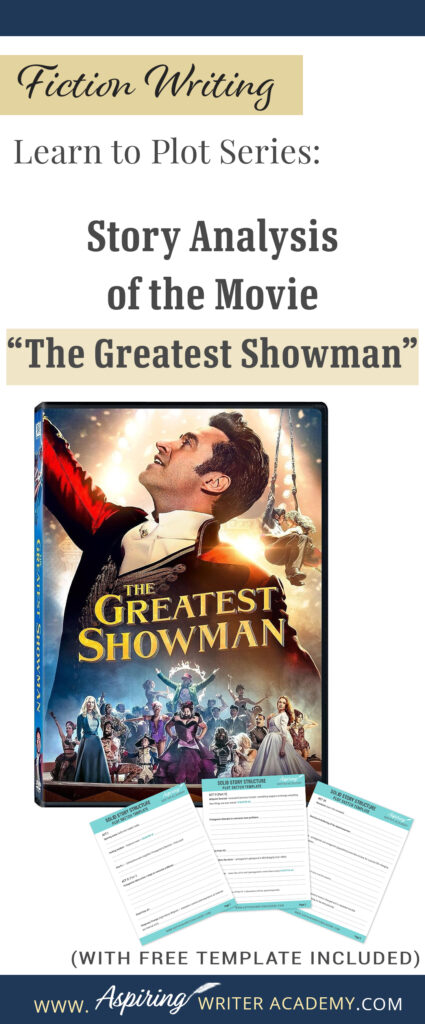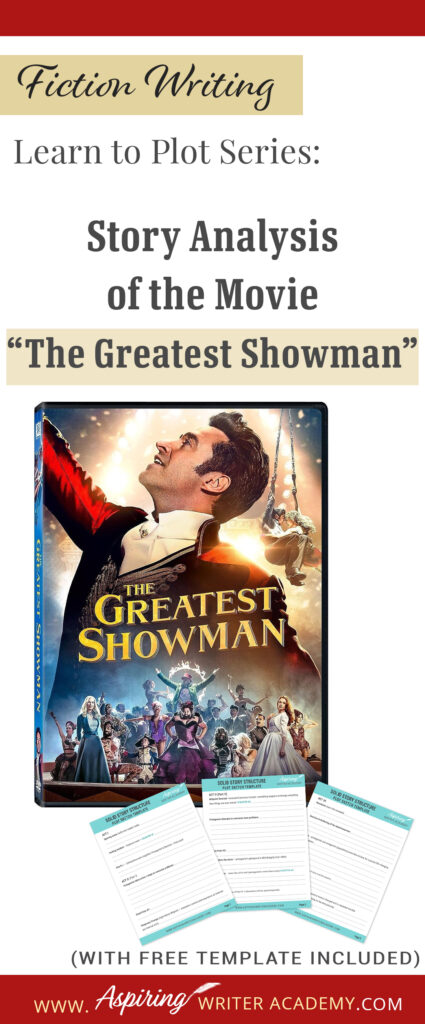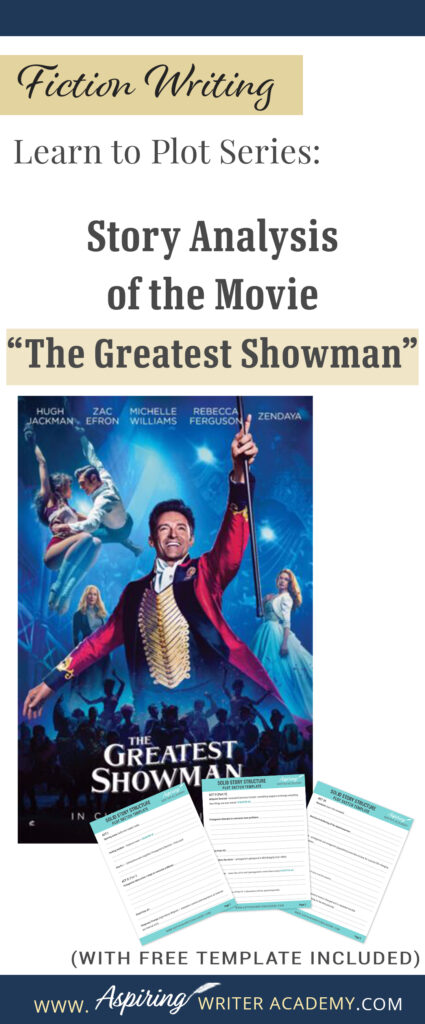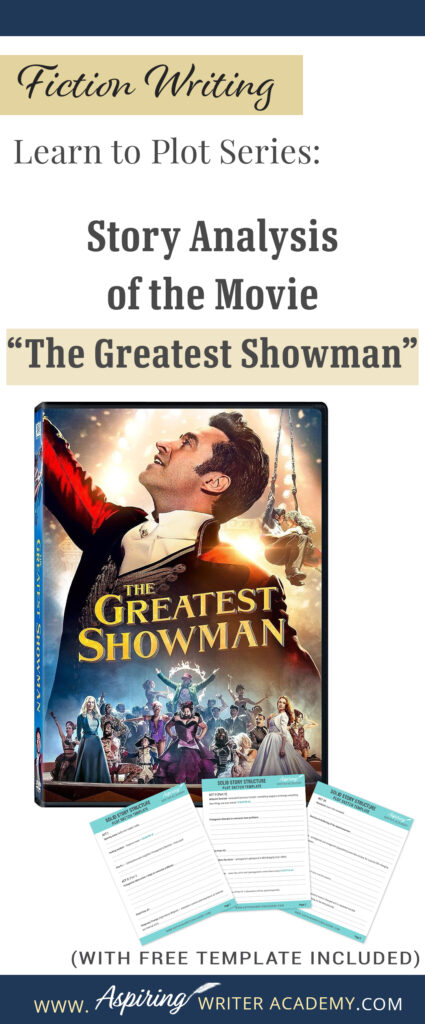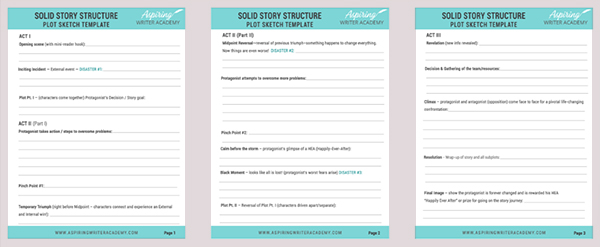Learn to Plot Fiction Writing Series: Story Analysis of the movie “The Greatest Showman”

The best way to learn story structure is to analyze good stories. Can you readily identify each plot point in every movie you see or book you read? Or do terms like ‘inciting incident,’ ‘midpoint reversal,’ and ‘black moment’ leave you confused?
In our Learn to Plot Fiction Writing Series: Story Analysis of the movie “The Greatest Showman” we show you how to recognize each element and provide a Free Plot Template so you can draft satisfying, high-quality stories of your own.
Amazon movie blurb: (partial)
The movie, “The Greatest Showman,” was released in April 2018 and stars: Hugh Jackman, Zac Efron, Michelle Williams, Zendaya, Rebecca Ferguson, and Keala Settle.
Hugh Jackman delivers a fantastic performance as P.T. Barnum in this spectacularly colorful musical for the whole family. Motivated by a desire to provide a good life for his wife (Michelle Williams) and children, Barnum founds a destined-to-be-famous circus which proves to be, not only immensely popular and profitable, but also a place in which a group of talented misfits can call home.
One of the best ways to learn story structure is to analyze as many movies and books as you can. We suggest you watch movies because you can see the whole story played out before you visually in approximately two hours, which may be quicker than reading an entire book.
We also suggest that you watch the movie with our Free Downloadable Solid Story Structure Plot Template beside you so that you can write down each plot point as soon as you see it appear on the screen. Do this twenty or so more times and you will soon be on your way to becoming a story structure expert!
Click to download our free Solid Story Structure Plot Sketch Template to help you analyze books or movies, and plot stories of your very own.
Warning! This post contains story spoilers. If you have not already seen the movie and do not want any story spoilers the first time around, you might want to watch the movie for enjoyment then watch it a second time using this post to help you identify each story element.

ACT I
Opening Scenes:
What do the opening scenes of “The Greatest Showman” accomplish? How do they serve to set up the story?
- Setting.
First, you need to establish the ‘ordinary world.’ When the movie opens, the reader/viewer is plunged straight into the exciting world of what will become the vibrant, colorful P.T. Barnum circus with performers, animals, daring acts.
Then the scenes fade to a young boy looking at himself in the mirror, showing he has big dreams of becoming someone great. His style of dress reveals he is from the poorer sect of the population and that this story is historical, set in the past around the 1850’s/1860’s.
- The first scene opens with an interesting situation (initial problem).
The story opens with the characters facing an initial problem, which acts as a hook to grab the reader’s attention. This isn’t the main problem yet, but a situation or event to get the story rolling. It is a scene that will tie into the major problem later.
Young P.T. Barnum accompanies his father, a tailor for the Hallet family, and uses his imagination to put together a teacup to imitate Mr. Hallet’s daughter, who is suffering through a lesson in high society social etiquette. Charity’s father is not as amused as she is, especially when she laughs and spills tea down her dress. Although P.T. Barnum apologizes for making her laugh, her father slaps him across the face, clearly telling him that he will never amount to anyone of significance.
This sets up the future conflict between P.T. Barnum and the Hallets, when he later marries Charity and also sets up P.T.’s obsessive goal of proving himself worthy.
- Introduction of the main characters, their personalities, and the character’s relationships with one another. Also hint at the internal (relationship) conflict and escalating external conflict.
The next scenes show young Charity sneaking out of her house to join P.T. Barnum at the beach and he takes her to an abandoned mansion where he shows her possibilities to light her imagination such as swirling animal figures on the walls.
Although P.T.’s father dies leaving him only his top hat, the boy sells old newspapers—shouting the headlines—and does whatever he can to survive on the streets and is surprised when a deformed woman shows kindness and offers him an apple.
P.T. keeps in touch with Charity through letters even though she has been shipped off to a private girls’ school. Once they are both grown, and P.T. comes to Charity’s house to take her away and marry her. Her father warns P.T. that Charity will be back when P.T. fails to foreshadow the future and cement P.T.’s goal of becoming successful.
Charity doesn’t care about money or success and only wants P.T. to share his dreams for the world they are going to create together—which starts with the birth of their two daughters.
Note: All of these ‘details’ are set up pieces that will show up again later and impact the story. Everything your character needs at the end should be set up in the beginning, so it is believable for the reader/viewer.
Ask—who are these characters and what will they need?
Inciting Incident:
After the opening scenes have introduced the characters and set up the genre, time period, location, hinted theme, and general pacing of the story, the protagonist is hit with the inciting incident, which rocks his (or her) ‘ordinary world’ and turns his life upside down. This serious problem cannot be ignored.
The protagonist must now decide how to deal with this serious problem, which becomes his new focus for the remainder of the story. The action plan to overcome this serious problem becomes the protagonist’s story-worthy goal.
In our ‘Learn to Plot’ story structure analysis of the movie, The Greatest Showman, the Inciting Incident occurs when P.T. Barnum finds himself out of a job when his workplace closes down. All he is left with is shares to a fleet of merchant ships that have sunk to the bottom of the South China Sea. He is sad, realizing this is not the life he promised Charity.
He gives a tin can lantern to his daughter for her birthday which spins light reflections onto the sheets hung about the rooftop of their apartment. The girls’ fascination reminds him of his dream to be successful and create a better world for his family. He must do something. This situation of having no income cannot be ignored. He must respond. He must take action.
The Inciting Incident or decision to go on the story journey often sends the characters through a doorway, or to a new location via a method of travel. The start of the new adventure separates Act I and Act II.
Note: The inciting incident is also referred to as the first major turning point to turn the story in a different direction or Disaster #1. What happens at the inciting incident is a game-changer.
If you are not familiar with the elements of solid story structure for popular fiction, you may want to see our post, How to Plot Your Fictional Novel, to help you further understand the specifics of what should be included in each section.
Plot Point I:
Plot Point I is the agreement between characters or decision the main character makes to accomplish a new story-worthy goal triggered by or in response to the inciting incident. This decision ends Act I. The main characters will unite to overcome the Inciting Incident problem.
In The Greatest Showman, (Click Here To Watch on Amazon) P.T. first goes to the bank to request a loan, which he receives, although deceitfully, by offering as collateral the shares to his fleet of merchant ships (which has sunk to the bottom of the sea.)
(He also sees a man named Charles at the bank whose dwarfism catches his interest.)
P.T. Barnum surprises his family when he decides to buy a museum to draw in crowds and make money.
If they do not find a way to sell tickets and make their business a success soon, they will not be able to survive, let alone pay back the 10,000. bank loan. This implies that there is now a ticking clock counting down to add tension to the story.
The stakes are set. They cannot ignore this problem. P.T. Barnum must find a way to make money and find success, which becomes his goal for the remainder of the story.
The goal will not be easy and there are dire consequences if they fail to achieve this goal. This sets up the story question:
Will P.T. Barnum become the successful entrepreneur he has always dreamed of being?
The audience is hooked and will continue watching/reading until the end of the story when this question is answered.

ACT II (Part I)
Now we journey into the main body of the story where the characters are learning to navigate their new ‘world/situation.’ The characters are learning, growing, being tested in their skills and in their relationships with one another. They are acquiring the know-how to face and deal with what is to come during the later segments of the story.
If the characters did not already transport to another location at the Inciting Incident, they may do so after the Plot Pt. I decision to go on the story journey. If the character does not actually travel, he may start a new job, or join a new group, or start to do something new, something that takes the character out of their comfort zone.
In The Greatest Showman, each character in is reaction mode during the first half of Act II as they learn to navigate their new circumstances.
Escalating events:
When P.T.’s idea to draw in crowds for the museum fails, his girls suggest he do something unique, something extraordinary that people would want to see. P.T. spots an apple on his desk and recalls the deformed woman who once gave him one, which sparks a new idea.
New characters are introduced:
P.T. goes to visit Charles, the tiny man with dwarfism he saw at the bank, and convinces him to be in his new show as a military captain riding a horse. Charles is reluctant, fearing people will laugh, but P.T. lures him in by saying they can put on a show that draws people from all over the world.
Next P.T. Barnum hangs posters inviting unique individuals to come join his show. He exaggerates the truth and announces to the public he’s found the world’s fattest man, tallest man, hairiest man, most tattooed man, an incredible trapeze brother and sister duo, a wolf boy.
He also finds a bearded woman who sings with an amazing voice. Each of these unique individuals had been considered ‘freaks’ by society and they wish to be considered equals, to become someone of significance, just as P.T. wishes to be. The team is afraid, but courageously steps out—and the audience loves the show!
Except for one newspaper critic, who calls the show a ‘circus.’ However, instead of taking offense, Barnum knows newspaper headlines can draw crowds from his boyhood experience and changes the name of his show to P.T. Barnum’s Circus to add even more intrigue.
Using his success to prove his self-worth and build a respectable life for his family, Barnum buys the abandoned mansion down the road from Charity’s parents they had once played in, he buys their eldest daughter, Caroline, the ballet slippers she’s always wanted, and their youngest daughter, Helen, a dollhouse.
Pinch Point #1:
This emotional moment usually occurs about midway through the first half of Act II.
- The first pinch point serves to remind the protagonist of the past and all he could lose if he doesn’t attain his goal. Pinch Point #1 also motivates him to continue forward with renewed resolve. He will not give up!
In our story analysis of The Greatest Showman Pinch Point #1 comes when Barnum and his family go to watch their daughter, Caroline, perform at her ballet recital. At this point in the story Barnum thinks he is doing well and has proven himself, giving his family their heartfelt desires for the life they wanted to make. It seems they have everything they’ve ever wanted.
Then after the recital Barnum sees Caroline being mocked by the other girls for being the daughter of a circus owner, saying she smells like elephants. They do not feel she is good enough to be associated with them, which reminds Barnum of his own childhood and how he felt. This inspires him to seek more success, to keep striving to win the respect of others so they will not look down on him or his family.
More escalating events:
Barnum tries to convince Mr. Phillip Carlyle to be his junior partner to gain affluence and prestige through Carlyle’s connections. Carlyle refuses but Barnum hits a nerve when he says Carlyle is trapped in his prestigious lifestyle and needs the freedom to live, laugh, and love. They strike a deal which will risk Carlyle’s reputation but give him 10 % of the profits.
Carlyle comes to the show and is instantly attracted to Anne Wheeler, the female trapeze artist, despite warning looks from her brother. This sets up a secondary romance subplot.
Protests in the streets erupt over the inclusion of unique individuals in the show. The protestors do not want them there. Their self-respect, as well as Barnum’s, is at stake.
Solution: Carlyle gets Barnum and his unique American ‘oddities’ an invitation to meet the Queen of England.
Barnum also meets Jenny Lind, the most famous opera singer in all of Europe. He has Carlyle introduce him and Barnum invites Miss Lind to tour with him in America to give the public something ‘real.’
Temporary Triumph:
In most stories the characters experience an unexpected win in the external plot thread that triggers a celebratory win or triumph between the characters in the internal plot thread. In a romance, this is where the characters may share some backstory and kiss. It looks like the characters may be able to achieve their goal and will get their happily-ever-after. This is a moment of hope, that yes, the character can win.
At Jenny Lind’s first performance in America, Barnum is nervous, hoping the woman can actually sing and bring him the success he desires, and she can! All of the elite of society is in attendance! Charity and his girls are excited for him, and it looks like Barnum has achieved his goal to prove himself and his family worthy.
The circus team of unique individuals are also mesmerized by Miss Lind.
Phillip Carlyle is moved by Miss Lind’s song of ‘wanting more’ and dares to hold hands with the trapeze artist, Anne, affirming their mutual attraction.

ACT II (Part 2)
Midpoint Reversal
Bam! Just when everything seems fine and the goal within reach, an event happens at Midpoint, the second major plot point, to turn the story (and all the plot threads) in a different direction again. Disaster #2 changes everything and reverses the short-lived temporary triumph. In a relationship story, it changes the relationship.
Miss Lind’s performance gains Barnum more credibility, even from the newspaper critic and Charity’s parents, who admit Barnum has done well for himself. Barnum should have had everything he’d always wanted at this moment, except his weakness of still needing to prove himself takes over and he ridicules Charity’s father for not believing in him. Miss Lind rescues the situation from a public scandal by quipping, “Mr. Barnum proves that one’s station is only limited by his imagination.”
However, Barnum has ruined any chance of a reconciliation with his in-laws. This upsets Charity as muchl as the look she saw on Barnum’s face when Miss Lind was singing, which showed he was infatuated with the opera singer. This signals trouble for their relationship.
Carlyle held hands with Anne, but as soon as he saw his parents turn to look at him, he quickly drew his hand away and Anne knew why. Carlyle is still trapped by his parents’ expectations and his need for their approval. He’s rich trying to make a relationship with someone of the perceived lower-class work, while Barnum is of the lower class trying to join the ranks of the elite. Their two story lines are the opposite of one another. And Barnum and Carlyle are both failing.
The circus performers find themselves shut out from the main party, implying they are not worthy to be seen in the company of the upper-class elite. Indignant, they storm through the middle of the party, demonstrating they will not be shut out or ignored or treated as inferior any longer. They embrace the belief that they are who they are meant to be.
- Notice that it is this midpoint mini sequence of events all happening at Miss Lind’s performance that slingshots the story over into Act II.
While many of the lessons learned in the first half of Act I may have been more exploratory or reactive, the second half is stepping out to use and test those lessons proactively. The characters have now been enlightened as to what is really going on and they are going after what they want!
Escalating events:
Barnum is letting his goal of achieving success and proving himself worthy take over. He plans to leave the circus and his family to go on tour with Jenny Lind, risking large amounts of money.
The circus team is upset he’s leaving without even saying goodbye and casting them aside with only Carlyle to direct them. As if they aren’t good enough anymore.
Carlyle buys a ticket for trapeze artist, Anne, to go to the opera, something she’s always wanted. But when they run into Carlyle’s parents and they degrade him for being with her, Anne saves her dignity by leaving. Carlyle follows her back to the circus where he tries to convince her of his affection, but she says a relationship between them is hopeless because of their differences in social status.
Pinch Point #2:
About halfway through the second half of Act II, we have Pinch Point #2. Another moment to pull on the heartstrings. While Pinch Point #1 reminded the main character why he must press forward with his goal, Pinch Point #2 also reinforces his motivation once again to achieve his goal and keep his focus on what is truly important.
Barnum says goodbye to his family and the girls run after him, not wanting him to go. The eldest daughter, Caroline, sees his empty seat beside her mother at her ballet recital and wishes he was there. So does Charity. All his family wants is him, to be a family. Notice how both pinch points center on Caroline at her ballet recital. The first reminds him of his past and the second represents his misguided quest to fix that self-worth problem for the future. But at what expense?
The Calm Before the Storm:
This is a moment when the story takes a slight pause so the audience can catch their breath. This can be another moment of hope that all will be well, similar to the temporary triumph. The character may see or experience something to give them hope for the future or a reason to press on with their original goal.
Jenny Lind has more successful performances on tour and makes it clear she wants a romantic relationship with Barnum and says, “I’ve given you everything you’ve ever wanted, haven’t I?” This jolts Barnum to the realization that this isn’t what he’s always wanted. He only wanted success to make a better life for his wife, Charity, and their girls. But his quest has driven him away from them.
The Black Moment:
The black moment is the dark night of the soul, the bleakest moment, which is also the third major turning point, Game Changer, or Disaster #3. It appears that all hope is lost.
When Barnum rejects her, Jenny Lind retaliates by kissing Barnum on stage amidst the cameras, creating a scandal that threatens to ruin him when the photo ends up in the newspapers. She also cancels the rest of her tour, leaving Barnum in serious financial debt.
Barnum returns home and learns the circus building is on fire. His symbolic ‘dream’ is burning down. When he learns Carlyle ran into the fire to find Anne, Barnum risks his life to carry him out despite the fact the building partially collapses on top of them. Anne, who was not in the building after all, runs to Carlyle and wonders if he will survive. The circus building is destroyed.
Plot Point II:
Plot Point II follows quickly on the heels of the Black Moment. This is when the characters separate or are driven apart due to the events of the Black Moment. The protagonist finds himself alone, struggling with what to do next.
At Plot Pt. II the characters are driven apart. (This is a reversal of Plot Pt. I where the characters all came together.)
Barnum returns home to find Charity, who saw the newspapers of him kissing Miss Lind, leaving to return home to her parents’ house, just as her father always said she would. She is taking the girls with her and tells Barnum the bank is taking the restored mansion he bought because they no longer have any money. Charity says he’s not in love with anyone but his show and with the circus building burned and the team scattered, Barnum is all alone.

ACT III
Revelation:
Then, suddenly the protagonist gets a new piece of information that changes the situation, and the characters can see how they might succeed in their battle against the external antagonist which they must face. The story’s theme is presented here as well.
Barnum shuffles through the ashes of the circus building and the newspaper critic says the authorities caught the culprits who started the fire and that he never liked the show, but says the people did. He tells Barnum he brought all people together as equals, a celebration of life.
Then, Charles and the other circus performers find Barnum in the bar having a pity party, believing all is lost. They remind him why he started the show in the first place—to change the world for his family. He realizes that he let chasing success blind him. The circus performers said they are grateful that he gave them all a family. They were afraid and alone and Barnum brought them all together and gave them a home (the circus). They encourage him not to give up.
Decision:
The revelation (new information revealed) helps the protagonist make a decision.
Barnum vows that from now on things will be different, that he will be different, and he runs to reconnect with his family.
Re-gathering of the Team or Resources:
Whatever people, tools, items are going to be needed for the climax are gathered together. If the protagonist’s team was separated at Plot Pt. II, this is when they come back together, realizing they need one another.
Anne visits the hospital and reunites with Carlyle, where they admit their love for one another.
Barnum goes to Charity’s parents’ house to get Charity and reunites with his girls. This bookends the story, mirroring the beginning, as he comes once again to her father’s house to take her away and he finds her at the beach just like another of the scenes from when they were young. Barnum apologizes to Charity, and they reunite.
Back at the burned circus grounds, Barnum tells the reunited circus team the bank has refused to give him a loan to rebuild. Carlyle comes in willing to reinvest his 10% because the circus changed his life and gave him a life of love. Barnum and Carlyle shake hands on a new deal to become partners splitting the profits 50-50 %.
Climax:
This is the most exciting scene sequence in the entire book or movie. This is a face-to-face confrontation between the protagonist (and his team) and the opposition. Either the protagonist succeeds once and for all or he fails. Everything is put on the line. It will not be easy.
In our analysis of the movie, The Greatest Showman, the antagonist Barnum is fighting against is society. Charity’s father puts a face on society as a whole, telling him he isn’t good enough. The protestors are fighting against the talented misfits that Barnum has gathered together, saying they aren’t worthy to be seen. The newspaper critic acts as an antagonist, never really giving Barnum the credit he deserves. It seems as if society as a whole is always trying to shut the circus down. So at the climax, Barnum and his circus team are going to fight back!
Barnum says they do not need the banks to buy another building, they can use a giant tent and buy land cheap down by the docks. They rebuild and when they reopen, their hearts are all in the right place and they finally find the life, love, and success they had always dreamed of having.
The show grows to be a huge success beyond their wildest dreams!
Resolution:
This is where the main storyline and all sub-plots are wrapped up with their reaction to what transpired at the Climax. The story journey has changed the protagonist. He/she can do things that they couldn’t do in the beginning. But the protagonist must do something to prove he’s changed. Show it.
The conflicts in both the external plot layer and the internal relationship plot layers have been faced and defeated. They have ‘won!’
Carlyle and Anne are now in a loving relationship with one another, fully embracing who they were meant to be and not caring what others think, and kiss in public.
Barnum hands his top hat to Carlyle, essentially handing the show over to him, saying, “The show must go on!” Barnum does not have to chase success or prove himself any longer. He has a loving family, friends, and has achieved a life of personal significance.
Final Image:
This is the very last image or scene of the entire story, a ‘capping off’ scene.
While Carlyle is running the show, Barnum and Charity attend their daughter’s ballet recital where their other daughter has a role disguised as a tree. The family is together, happy, and have all they ever wanted. Barnum has found a way to support his family and give them a good life.
Additional Thoughts:
How does this story structure line up with your own writing? Have you included all the steps or are you missing some?
Bottom of FormI hope that you have enjoyed our Learn to Plot Fiction Writing Series: Story Analysis of the movie “The Greatest Showman” and have downloaded the Free Solid Story Structure Plot Template to analyze more books and movies, or perhaps to outline a story of your own.
Download our Free Solid Story Structure Plot Sketch Template

You May Also Like
If you have any questions or would like to leave a comment below, we would love to hear from you!
If you like more help developing your story, you may wish to download our Free Brainstorming Your Story Idea Worksheet
Do you find it difficult to create compelling antagonists and villains for your stories? Do your villains feel cartoonish and unbelievable? Do they lack motivation or a specific game plan? Discover the secrets to crafting villains that will stick with your readers long after they finish your story, with our How to Create Antagonists & Villains Workbook.
This 32-page instructional workbook is packed with valuable fill-in-the-blank templates and practical advice to help you create memorable and effective antagonists and villains. Whether you're a seasoned writer or just starting out, this workbook will take your writing to the next level.
Our Goal for Aspiring Writer Academy is to help people learn how to write quality fiction, teach them to publish and promote their work, and to give them the necessary tools to pursue a writing career.

ENTER YOUR EMAIL BELOW
TO GET YOUR FREE
"Brainstorming Your Story Idea Worksheet"
7 easy fill-in-the-blank pages,
+ 2 bonus pages filled with additional story examples.
A valuable tool to develop story plots again and again.
Other Blog Posts You May Like
How to Plot Your Fictional Novel (with Free Template Included)
Structuring Act II (Part 1) for Maximum Impact: How to Keep Readers Engaged
Structuring Act II (Part 2) for Maximum Impact: How to Keep Readers Engaged
How to Write Act III and Finish Your Fictional Story in 5 Steps
Learn to Plot Fiction Writing Series: Story Analysis of “Beauty and the Beast”
Fiction Writing: Story Analysis of the movie “Passengers”
Learn to Plot Fiction Writing Series: Story Analysis of the movie “Signs”
Learn To Plot Fiction Writing Series: Story Analysis of the Movie “Top Gun: Maverick”
Learn to Plot Fiction Writing Series: Story Analysis of the Disney movie “Frozen”
Learn to Plot Fiction Writing Series: Story Analysis of the movie “Jumanji: Welcome to the Jungle”

is a multi-published author, speaker, and writing coach. She writes sweet contemporary, inspirational, and historical romance and loves teaching aspiring writers how to write quality fiction. Read her inspiring story of how she published her first book and launched a successful writing career.

